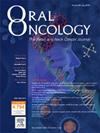鼻咽癌鼻衄的特点和治疗方法
IF 4
2区 医学
Q1 DENTISTRY, ORAL SURGERY & MEDICINE
引用次数: 0
摘要
摘要] 目的 分析鼻咽癌(NPC)患者鼻衄的危险因素并探讨有效的治疗方法。 方法 2006年3月至2020年2月,本中心共收治351例鼻衄患者,其中195例符合纳入标准。结果总出血量的中位数为 100.0 毫升(范围为 20-4430 毫升)。非大量鼻衄和大量鼻衄患者分别为 126 人(64.6%)和 69 人(35.4%)。大面积鼻衄患者的 1 年总生存率(OS)为 60.1%,而接受加强型止血治疗的非大面积鼻衄患者的 1 年总生存率(OS)为 97.3%。在大面积鼻衄患者中,接受CTPI治疗的患者的1年OS率为80.0%,接受阶梯止血治疗的患者的1年OS率为13.3%。阶梯止血治疗对控制非严重性鼻衄有效。CTPI急救法可能是鼻咽癌大面积鼻衄患者的有效止血疗法,尤其是那些有PRNN和ICA暴露的患者。本文章由计算机程序翻译,如有差异,请以英文原文为准。
Characteristics and treatment of epistaxis in nasopharyngeal carcinoma
Objectives
To analyze the risk factors and explore effective treatments for epistaxis in nasopharyngeal carcinoma (NPC) patients.
Methods
From March 2006 to February 2020, 351 epistaxis patients visited our center and 195 patients meeting the inclusion criteria were enrolled in the study. Characteristics and treatments, including step-up hemostatic treatment (including medication, anterior ± posterior nostril packing, or further surgical hemostasis) and the CTPI emergency hemostasis method (including common carotid artery compression, tracheotomy / intubation, packing of nasal and nasopharynx, and interventional treatment), were analyzed.
Results
The median total bleeding volume was 100.0 ml (range 20–4430 ml). 126 (64.6 %) and 69 (35.4 %) patients suffered from non-massive epistaxis and massive epistaxis. The 1-year overall survival (OS) rate was 60.1 % for patients with massive epistaxis and 97.3 % for those with non-massive epistaxis treated with step-up hemostatic treatment. Among patients with massive epistaxis, the 1-year OS rate was 80.0 % for those who received CTPI and 13.3 % for those who received step-up hemostatic treatment.
Conclusion
ICA exposure and hemostasis failure was adverse prognostic factors for OS in NPC patients with epistaxis. The step-up hemostatic treatment is effective for controlling non-massive epistaxis. The CTPI emergency method might be an effective hemostasis treatment for NPC patients with massive epistaxis, especially those with PRNN and ICA exposure.
求助全文
通过发布文献求助,成功后即可免费获取论文全文。
去求助
来源期刊

Oral oncology
医学-牙科与口腔外科
CiteScore
8.70
自引率
10.40%
发文量
505
审稿时长
20 days
期刊介绍:
Oral Oncology is an international interdisciplinary journal which publishes high quality original research, clinical trials and review articles, editorials, and commentaries relating to the etiopathogenesis, epidemiology, prevention, clinical features, diagnosis, treatment and management of patients with neoplasms in the head and neck.
Oral Oncology is of interest to head and neck surgeons, radiation and medical oncologists, maxillo-facial surgeons, oto-rhino-laryngologists, plastic surgeons, pathologists, scientists, oral medical specialists, special care dentists, dental care professionals, general dental practitioners, public health physicians, palliative care physicians, nurses, radiologists, radiographers, dieticians, occupational therapists, speech and language therapists, nutritionists, clinical and health psychologists and counselors, professionals in end of life care, as well as others interested in these fields.
 求助内容:
求助内容: 应助结果提醒方式:
应助结果提醒方式:


